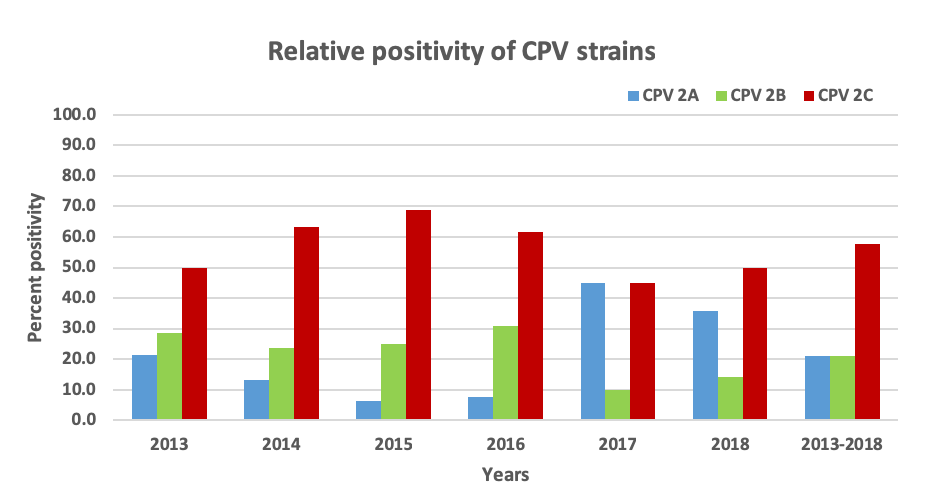May 2019
Canine Parvoviral Infections - A five-year data summary of antigenic variants
By Drs. Vinay Shivanna and Cynthia Bell
Parvoviral enteritis is a severe and often fatal disease in dogs that is caused by Canine parvovirus 2 (CPV-2). This virus first emerged in dog populations in 1978, simultaneously occurring in multiple countries worldwide. CPV-2 can infect other wild canids including coyotes, raccoon dogs and gray wolves. CPV-2 (also called CPV-2a) is the original strain and two antigenic variants of the virus (CPV-2b and CPV-2c) emerged during the past 4 decades. Currently, each of the 3 variants circulates globally and CPV-2c is known to be the most antigenically distinct [1]. Most commercially available vaccines are developed against either CPV-2a or CPV-2b but are considered to be cross-protective against all variants/strains of the virus.
CPV can be found anywhere in the environment and infection of a dog upon contact depends on several factors, particularly the dog’s immune status. After an incubation period of 3-7 days following exposure, the virus initially infects lymphoid progenitors in the bone marrow and depletes them, causing immunosuppression. Subsequently, the virus infects crypt cells of the intestine. Three syndromes are associated with CPV infection. In puppies younger than 2 weeks, a generalized infection occurs with necrosis affecting most vital organs. Some 3-8-week-old puppies may develop myocarditis and myocardial scarring that leads to sudden death weeks to months later. Puppies older than 8 weeks develop the most common enteric form, which is characterized by segmental necrotizing enteritis +/- Clostridial enterotoxaemia, leading to bloody diarrhea, dehydration and fatal shock. Infected dogs generally exhibit lethargy, depression, high fever, vomiting and diarrhea.
Through the KSVDL necropsy service, we occasionally see classic parvoviral enteritis in adult, vaccinated dogs. This observation prompted our interest in reviewing all Canine Parvovirus PCR results at the Kansas State Veterinary Diagnostic Laboratory (KSVDL) from 2013 to 2018. Of 441 samples from dogs that were tested by PCR, 118 cases were positive with 25 cases of CPV-2a, 25 cases of CPV-2b, and 68 cases of CPV-2c. Neither vaccination status nor clinical information regarding severity of disease was available to correlate with these findings, but the data show that CPV-2c is the most prevalent field strain in samples tested at KSVDL.
 |
|
Click to enlarge. |
The KSVDL PCR results clearly show the importance of monitoring for antigenic variants and the necessity for vaccines to broadly protect against all prevalent strains. It is interesting that the CPV-2c was detected most commonly – this variant emerged most recently and has not been used for vaccine production. Nevertheless, these data are insufficient to support any particular conclusion regarding the efficacy of current vaccines.
Screening for CPV infection in the veterinary clinic is common by the fecal ELISA; these tests are rapid and easy, but a lack of sensitivity increases the risk of false negative results. Polymerase chain reaction (PCR) offers a more accurate method that detects viral particles within fecal samples with high sensitivity and specificity.
Good environmental hygiene and proper vaccination are best practices for prevention of CPV infection. Maternal immunity provides protection for a limited time and wanes before the puppies develop full vaccination immunity – this creates a window during which time puppies are particularly vulnerable to infection. Multiple factors may contribute to a dog’s failure to develop protective immunity following vaccination and adhering to vaccination guidelines is advised [2].
References:
- Cavalli A, Martella V, Desario C, Camero M, Bellacicco AL, De Palo P, Decaro N, Elia G, Buonavoglia C: Evaluation of the Antigenic Relationships among Canine Parvovirus Type 2 Variants. Clinical and Vaccine Immunology 2008, 15(3):534-539.
- Canine Vaccination Guidelines
NEXT: Blue-Green Algae season is approaching
Return to Index
